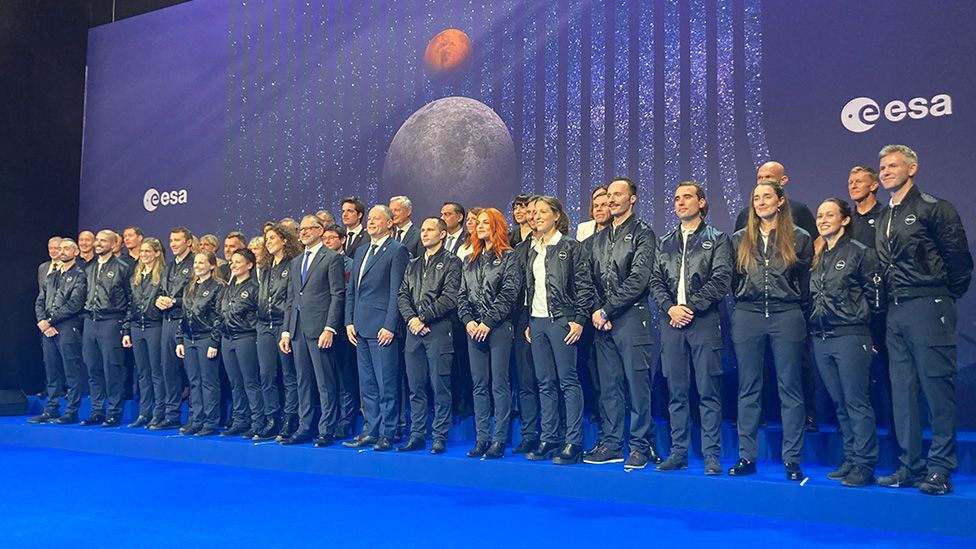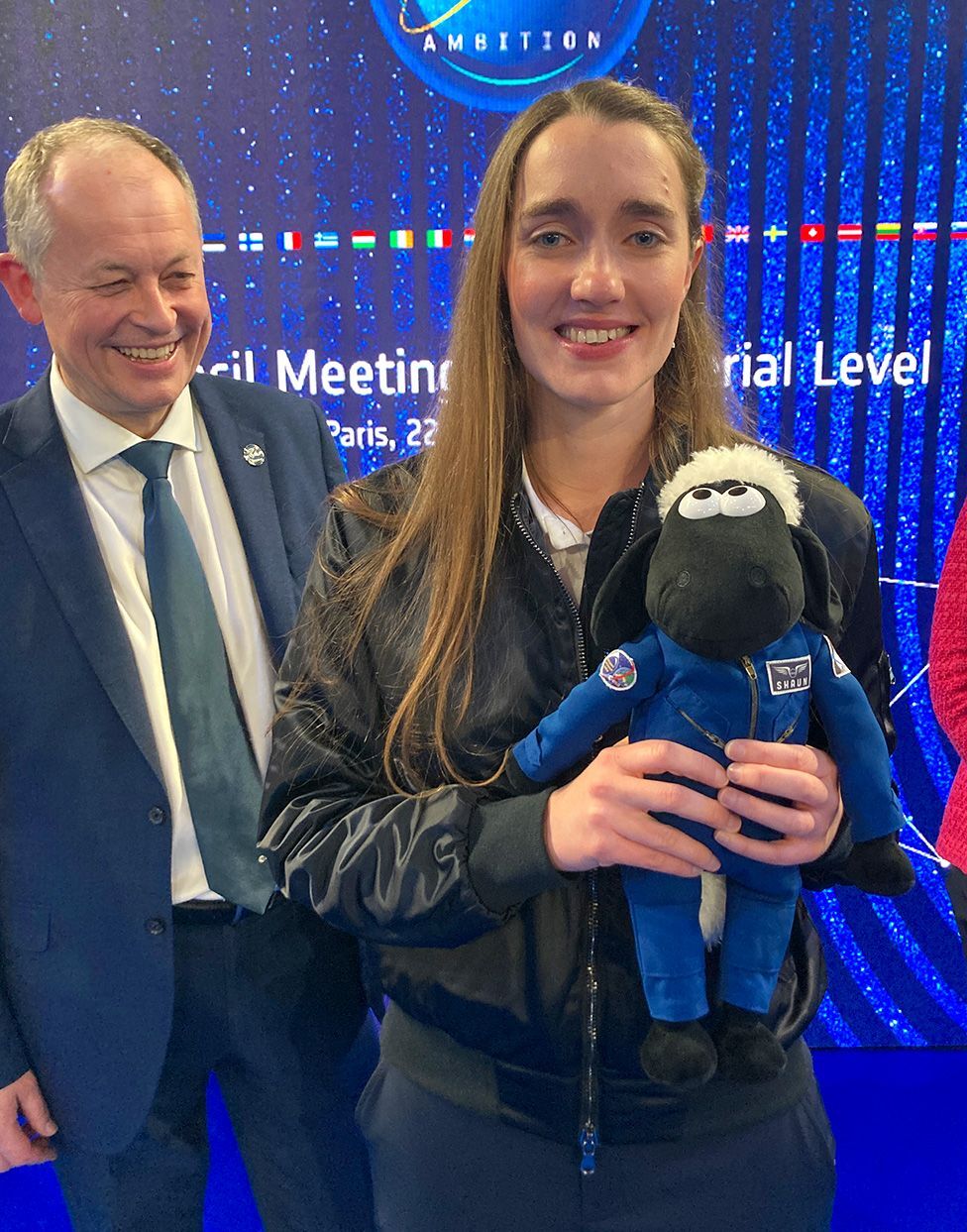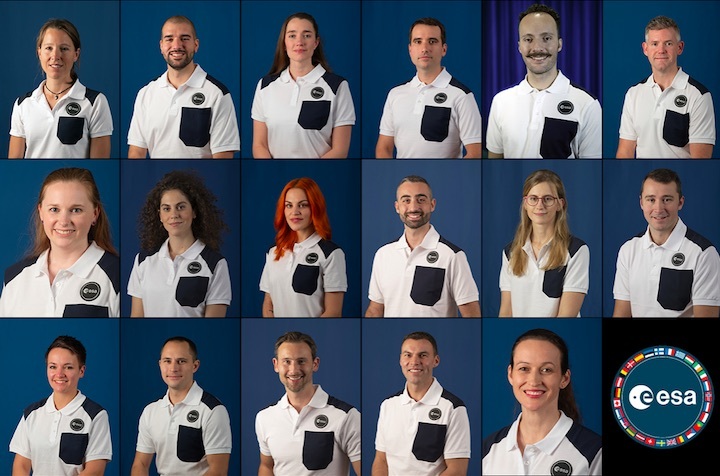25.11.2022
A disabled British man has been chosen for astronaut training by Europe's space agency, a world first.
John McFall, 41, joined 16 men and women selected for the European Space Agency's (Esa) first new class of astronauts in 13 years.
His right leg was amputated after a motorcycle crash when he was 19. He became a professional athlete and represented Team GB at the Paralympics.
Another British woman, Rosemary Coogan, was selected as a career astronaut.
Esa said it wanted to widen the definition of what it means to have "the right stuff" to go into space.
This announcement does not mean McFall is guaranteed to go into orbit. Instead, he will be part of a feasibility programme to see what the requirements would be for that to be possible.
McFall, who won a bronze medal at the Paralympic Games in 2008 in the T42 100 metres, said he was proud and grateful to have been given the opportunity in "such a brave and bold project".

The astronaut candidates and European research ministers line up for a family photo
He told the BBC he had not previously considered becoming an astronaut but felt compelled to apply when he saw the opportunity.
"When Esa announced that they were looking for candidates with a physical disability to run this astronaut feasibility project, I looked at the person specification and it just kind of jumped out to me," he said.
"I felt so inspired by it. I felt compelled to apply."
Esa will be working with Nasa on the feasibility study. They need to establish first that a para-astronaut's inclusion wouldn't compromise crew safety. It's also possible the space vehicles in which they travel will need adaptations.
"It's really important for us to involve everybody that has an excitement about space," said Dr David Parker, Esa's director of human and robotic space exploration.
"We're making a first step by opening up this call to people that have certain types of physical disability, and we really hope we'll be flying them on a mission to the International Space Station," he told BBC News.
UK science minister George Freeman hailed the selection.
"We inspired the world at London 2012 with the Paralympics, and I'm so proud that we'll be the first country to put a para-astronaut in space and show that space is indeed the new frontier. It's where humanity comes together, and it's where we destroy the barriers that are holding back this planet and mankind. It's a brilliant day for British science, and for British values," he said.
Meanwhile, the five new "career" astronauts are guaranteed flights, assuming they come though their training. They were chosen from more than 20,000 applicants.
The number of women wanting to join the corps was up significantly on the last recruitment in 2009, and this has fed through to the final selection. Esa director general Josef Aschbacher said almost 50% of the recruits were women.
One of those is astrophysicist Rosemary Coogan, 31, who has become the first British female Esa astronaut.

Rosemary Coogan celebrates her recruitment with her new boss, David Parker, and Esa mascot Shaun the Sheep
Speaking to the BBC in Paris, Coogan said "Today is the beginning" and the training will be incredibly exciting, adding that she and her colleagues will "all be in it together".
"I just feel really strongly about all of the things that space can do for us," she said.
It means Samantha Cristoforetti will no longer be Esa's sole female astronaut.
"I am just over-happy that finally we have some new colleagues," she said. "It's going to be a much more diverse group, and I'm certainly looking forward to not being any more the only woman astronaut in the European astronaut corps. That's important because the current composition of our corps does not reflect where we are in society."
The other Brit on stage in Paris was Meganne Christian, 34. She is an "also suitable" - a reserve and will only get called into the professional corps if there is a vacancy or the UK government were to press for it with extra funding. However, she has joint UK-Australian citizenship, and so there may be a route to space for her through the recently created Australian Space Agency.
The other career astronauts announced in Paris were:
- Marco Sieber, from Switzerland
- Raphaël Liégeois, from Belgium
- Pablo Álvarez Fernández, from Spain
- Sophie Adenot, from France
Their employment with Esa, and their two-year training programme, will start in April next year.
As well as the astronaut showcase on Wednesday, Esa and its member states announced a €16.9bn (£14.7bn; $17.5bn) funding package for space programmes over the next five years.
Quelle: BBC
+++
ESA announces new astronaut class, including first 'parastronaut'

The European Space Agency (ESA) has selected its first new astronaut class in 13 years, including five men and women who will report for training in 2023, 11 "reserve" members who will return to their day jobs until they are needed and one "parastronaut" who will demonstrate that having a disability is not a barrier to spaceflight.
Selected from a pool of more than 22,500 applicants from 25 European nations, the 17-member 2022 class includes trainees from Austria, Belgium, the Czech Republic, France, Germany, Italy, Poland, Spain, Sweden, Switzerland and the United Kingdom. The group includes eight women and nine men.
"If you look at these wonderful people here, of course the selection was about talent and about capabilities to be a fantastic astronaut, but I'm also very proud that it happens to be a very good distribution of genders," Josef Aschbacher, ESA director general, said at the Grand Palais Éphémère in Paris, where the new astronauts were announced on Wednesday (Nov. 23). "So we have almost 50 percent ladies in this group and I think that's also very important and from very different countries."
Of the 17, only six will report at first to the European Astronaut Center in Cologne, Germany to begin their basic training next year. The other 11 candidates will return to their places of work until such time that more flight opportunities are available.
"The astronauts in the reserve pool are astronauts as the name says, so there is no difference. They are astronauts, but they are not yet engaged by ESA directly through a permanent contact. They will be available for future astronaut activities," said Aschbacher. "We will give them a short contract so that they work with us and we can interact with them regularly. Then, if opportunities arise maybe later on, they can then be put into baseline training for future missions."
The five "career" astronauts and parastronaut will train for missions on board the International Space Station, while the seven veteran members of the 2009 ESA astronaut class are considered for moon missions with NASA's Artemis program.
The 2022 career astronauts include:
-
Sophie Adenot, 40, helicopter experimental test pilot from France
-
Pablo Álvarez Fernández, 34, aeronautical engineer from Spain
-
Rosemary Coogan, 31, astronomer from Northern Ireland (UK)
-
Raphaël Liégeois, 34, neuroscientist from Belgium
-
Marco Sieber, 33, emergency medical doctor from Switzerland
The reserve members include:
-
Meganne Christian, 35, chemist and CEO from the UK
-
Anthea Comellini, 30, flight controller from Italy
-
Sara García Alonso, 33, biomedical scientist from Spain
-
Andrea Patassa, 31, experimental test pilot from Italy
-
Carmen Possnig, 34, space physiologist from Austria
-
Arnaud Prost, 30, flight test engineer from France
-
Amelie Schoenenwald, 33, medical expert manager from Germany
-
Aleš Svoboda, 36, weapons and tactics officer from Czech Republic
-
Sławosz Uznański, 38, senior reliability engineer from Poland
-
Marcus Wandt, 42, chief test pilot from Sweden
-
Nicola Winter, 37, fighter pilot and risk management trainer from Germany
John McFall was chosen to be ESA's first parastronaut. A 41-year-old surgeon and professional athlete from the UK, McFall was 19 when a motorcycle accident resulted in the amputation of his right leg.
"With my broad scientific background and vast range of experiences, I felt compelled to try and help ESA answer this question: Can we get someone with a physical disability to do meaningful work in space?" said McFall.
David Parker, ESA's director of human and robotic exploration, said that McFall's selection was done using the same criteria as ESA used to choose the other 16 members of the 2022 astronaut class.
"We are going to work with [McFall] to understand how to adapt the space vehicle — maybe it's something aboard the space station — to ensure that [he] can live and work and do a meaningful mission aboard the station," said Parker.
Since 1988, the European Astronaut Corps has included 30 members, of which seven are active today: Samantha Cristoforetti, Alexander Gerst, Andreas Mogensen, Luca Parmitano, Timothy Peake, Thomas Pesquet and Matthias Maurer. All seven have flown to the International Space Station, with four going twice (a fifth, Mogensen, is assigned to his upcoming second flight).
"We are excited to welcome the new astronaut class of 2022 and I am looking forward to see all these ambitious young career astronaut candidates joining us for their first training at ESA's European Astronaut Centre in spring 2023, going forward to explore and shape space exploration," said Frank De Winne, head of the European Astronaut Centre, ESA's International Space Station program manager and a former ESA astronaut.
Quelle: CS

